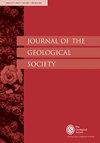根据新获得的地震反射数据,纽芬兰近海Flemish Cap的结构配置和构造
IF 3
3区 地球科学
Q2 GEOSCIENCES, MULTIDISCIPLINARY
引用次数: 0
摘要
虽然佛兰德帽在北大西洋的打开中发挥了关键作用,但由于地震覆盖范围不足,对这一大陆带的构造历史知之甚少。在这项研究中,我们展示了在佛兰德盖上新获得的13条地震反射剖面,在这些剖面上,地震反射面在顶部声学基底上和底部都显示出高度变化的地震相,并具有特殊的层状地壳结构成像。上地壳的主要特征是透明、混沌的振幅反射率。下地壳,特别是盖层的两侧,显示出相对明亮和连贯的反射包,根据裂谷前板块重建的陆上-海上对比,可以解释为阿巴拉契亚造山构造。佛兰德盖层大陆地壳内的伸展体系记录了古生代造山崩塌与前侏罗纪裂陷之间的过渡阶段。此外,还绘制了与佛兰德盖区中生代裂谷作用相关的地壳结构图,解释的不同裂谷域显示出沿走向的变化。综上所述,佛兰芒盖层的构造历史以古生代造山期韧性变形为主,造山裂陷过渡期以韧性变形和脆性-韧性变形为主,侏罗纪-白垩纪主要裂陷期为脆性变形。本文章由计算机程序翻译,如有差异,请以英文原文为准。
Structural configuration and tectonics of the Flemish Cap, offshore Newfoundland, from newly acquired seismic reflection data
While the Flemish Cap played a pivotal role in the opening of the North Atlantic, the tectonic history of this continental ribbon has been poorly constrained due to insufficient seismic coverage. In this study, we present thirteen newly acquired seismic reflection profiles over the Flemish Cap, on which seismic reflectors show highly variable seismic facies both on and beneath the top acoustic basement, with exceptional imaging of layered crustal structure. The upper crust is primarily characterized by transparent, chaotic amplitude reflectivity. The lower crust, particularly on the flanks of the cap, exhibits relatively bright and coherent reflection packages interpreted as Appalachian orogenic fabrics based on onshore-offshore correlations from pre-rift plate reconstructions. Extensional systems within the continental crust of the Flemish Cap record a transitional stage between Paleozoic orogenic collapse and pre-Jurassic rifting. The crustal architecture associated with Mesozoic rifting of the Flemish Cap is also mapped and the interpreted distinct rift domains display along-strike variations. Overall, the complex tectonic history of the Flemish Cap involved dominantly ductile deformation during the Paleozoic orogenic stage, multiple deformation styles (primarily ductile and brittle-ductile) during the orogen-to-rift transitional stage, and brittle deformation during the major Jurassic-Cretaceous rifting stage.
求助全文
通过发布文献求助,成功后即可免费获取论文全文。
去求助
来源期刊

Journal of the Geological Society
地学-地球科学综合
CiteScore
6.00
自引率
3.70%
发文量
68
审稿时长
6-12 weeks
期刊介绍:
Journal of the Geological Society (JGS) is owned and published by the Geological Society of London.
JGS publishes topical, high-quality recent research across the full range of Earth Sciences. Papers are interdisciplinary in nature and emphasize the development of an understanding of fundamental geological processes. Broad interest articles that refer to regional studies, but which extend beyond their geographical context are also welcomed.
Each year JGS presents the ‘JGS Early Career Award'' for papers published in the journal, which rewards the writing of well-written, exciting papers from early career geologists.
The journal publishes research and invited review articles, discussion papers and thematic sets.
 求助内容:
求助内容: 应助结果提醒方式:
应助结果提醒方式:


